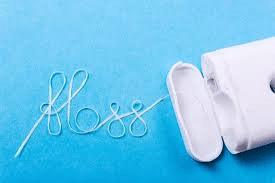Become a Floss Boss!
When was the last time you flossed your teeth? Admit it – not since you got a wodge of bacon stuck between your molars that time after a hearty breakfast, and that wasn’t even floss; it was a bit of spare thread hanging off your cardigan.
Although we Irish have become far more dentally aware in recent years, we’re still fairly lax when it comes to flossing our teeth. So, what’s the big deal? We brush twice a day – isn’t that enough? No, it’s not! New Year is the perfect time to incorporate flossing into your day.
Disgusting stuff grows in your mouth
Just brushing your teeth mornings and evenings doesn’t do enough to keep plaque at bay.
Those teensy little scraps of food that get lodged between your teeth and around the gum line start to decay as the day wears on. They get smelly.
They attract bacteria, who are delighted to have such conveniently placed goodies to swarm all over.
Bacteria begin to multiply rapidly, feasting on those little morsels of food and secreting nasty tooth-eroding acids as they dine. These bacteria are the precursors of plaque; that soft coating that makes your teeth feel like they are wearing furry jumpers.
Brushing your teeth only moves plaque from the surfaces the bristles can reach, leaving plenty of plaque wedged between teeth and around the gum line. That plaque hardens into tartar, the villain that leads to tooth decay; gum disease and tooth loss.
Why Floss?
Flossing regularly is as important as brushing.
Only floss can reach all the nooks and crannies where plaque and bacteria like to hide.
Flossing after meals will get rid of lurking food scraps (it is not a spectator sport; best performed alone in the bathroom) and keep the sides of the teeth smooth so plaque can’t stick. It also protects the gum line by dislodging plaque that would otherwise harden into tartar.
Flossing Guidelines
There are many different flosses on the market from waxed or unwaxed; to flavoured flosses or even floss attached to a handle, like a tiny archer’s bow.
It doesn’t matter what your personal preference is; the mechanics of flossing are standard. Take a piece of floss about 15 inches long and wind each end around your index fingers.
Slide the floss between your teeth and wrap it around the side of the tooth, working it up and down to scrape off plaque.
Do the same against the side of the adjacent tooth; then move on to a fresh spot on your length of floss and the next tooth. It’s better to work systematically around your mouth, and pay careful attention to the molar teeth at the back where it can be difficult to fit the floss.
Regular flossing will not only keep your teeth plaque-free; it can alert you to any tell-tale signs of health problems. Bleeding gums, for example, may indicate gum disease and the bacteria present in your mouth will migrate through your bloodstream, potentially causing inflammation elsewhere in your body.
If your gums bleed at first, gently floss and brush more often until they no longer bleed. If the bleeding persists, come and see us. Call us on 021 432 0004 or see smilestore2018.like.energy
Latest posts
Tax Relief
Tax relief is available on many different dental procedures available at Smile Store – The Dental Specialists.
Call backContact us
Request a call back to met one of our friendly staff!


















